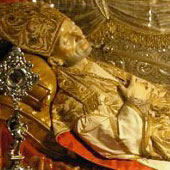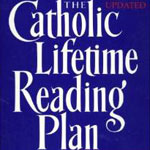 Today, 25 March, is usually the Feast of the Annunciation. (Since we have entered into Holy Week, this year the feast is transferred to the next available day: 8 April.)
Today, 25 March, is usually the Feast of the Annunciation. (Since we have entered into Holy Week, this year the feast is transferred to the next available day: 8 April.)
It’s no coincidence that Christmas is celebrated in exactly nine months time. The two feasts are related. As you would expect, nine months separates the celebrations of the Lord’s conception and birth.
But which came first? The Annunciation or Christmas? What I mean is, did the Church nominate 25 December as the Feast of the Nativity, and count back nine months to nominate the Feast of the Incarnation? Or did the Church nominate 25 March as the Feast of the Incarnation, and count forward nine months to nominate the Feast of the Nativity?
The evidence points to the latter. Christians were slow to celebrate birthdays, which had pagan connotations, and our Lord’s birthday was no exception. But celebrating the event of the Incarnation carried no such baggage. It seems that the liturgical feast of the Annunciation is many centuries older than the feast of the Nativity. But why nominate 25 March as the date of Jesus’ conception?
Good Friday: 25 March AD 29
In the earliest extant writing on the subject, Tertullian identifies the date of Jesus’ conception with the date of Jesus’ death. (According to ancient Hebrew tradition, the great prophets died on the anniversary of their conception.) And the date of Jesus’ death, Tertullian, writes, is 25 March AD 29.
And the suffering of this “extermination” was perfected within the times of the lxx hebdomads, under Tiberius Cæsar, in the consulate of Rubellius Geminus and Fufius Geminus, in the month of March, at the times of the passover, on the eighth day before the calends of April, on the first day of unleavened bread, on which they slew the lamb at even, just as had been enjoined by Moses. 1
The eighth day before the calends of April is 25 March, the vernal equinox — in the ancient world, the first day of spring. Tertullian writes in 220 as though it’s already a well established tradition in the Church to celebrate the anniversary of Christ’s death on 25 March.
This is apparently an idea that persisted for many centuries, since we find Augustine making the same claim in 431:
For He is believed to have been conceived on the 25th of March, upon which day also He suffered. 2
Adding weight to this tradition is the liturgical feast of St Dismas — the good thief who defended Jesus at Calvary. Saints are usually celebrated on the anniversary of their death. St Dismas, obviously, shares his anniversary of death with Jesus. And his feast day? 25 March.
In the Julian calendar, the vernal equinox (25 March) was recognised not only as the first day of Spring, but also the first day of the new year. It’s only since 1752 that England celebrates 1 January as New Year’s Day. To the mind of Christendom, it was only fitting that Jesus should be conceived at the start of a new year, and that he should die at the start of a new year. After all, the Incarnation and the Redemption inaugurated new epochs in human history.
Good Friday: 14 Nisan
The Ancient Israelites, of course, were loathe to use the Julian calendar of the Romans. They maintained their own Hebrew calendar which was lunar, not solar.
It’s much easier to identify the date of Jesus’ death by this calendar. The Scriptures very clearly juxtapose Jesus’ death and the Paschal feast, which occurred in the month of Nisan.
Although there is a tendency to identify the Last Supper with the Passover meal, the Gospel of John suggests that Jesus died on the fourteenth day of Nisan, which in lunar terms is the first full moon after the vernal equinox, and in ritual terms, the day before Passover.
We read in John’s Gospel that the Jewish authorities who arrested Jesus and presented him to Pilate:
“would not enter the palace themselves; there was the paschal meal to be eaten, and they must not incur defilement.” (Jn 18:28)
More explicitly, in setting the scene for Pilate’s verdict, the evangelist writes:
“It was now about the sixth hour, on the eve of the paschal feast.” (Jn 19:14)
παρασκευὴ τοῦ πάσχα : the day of Preparation for Passover. This is significant. It means that at the ninth hour — the hour of Jesus’ death — the priests were slaughtering the paschal lambs in the Temple.
In the Talmudic tradition, the fourteenth day of Nisan corresponds not only with the slaughter of the spring lambs in Egypt, and the smearing of the lambs’ blood over the doors of the Hebrews. It corresponds too with the creation of the world, the birth of the patriarchs, and Abraham’s near-sacrifice of Isaac.
This was the learned opinion of the Rabbi Eliezar, anyway. The Rabbi Joshua begged to differ.
So. If you follow the Talmudic and Patristic traditions, a lot of history is packed into 25 March. It is the first day of Creation. It is the shared birthday of the Hebrew patriarchs. It is the day that Abraham meant to sacrifice his son Isaac. It is the day the Hebrew slaves in Egypt sacrificed the first paschal lambs. It is the day the Word became flesh. And it is the day that our Lord died on the cross and conquered death.
I should add, though, that though ancient scholars coalesced towards 25 March AD 29 as the date of Jesus’ death, modern scholars nominate 7 April, AD 30. Maybe that’s something I’ll blog about in a fortnight.
Notes:
- [1] Tertullian, An Answer to the Jews, VIII:17. Translated by S. Thelwall in The Ante-Nicene Fathers, Volume III: Latin Christianity: Its Founder, Tertullian, ed. Alexander Roberts, James Donaldson and A. Cleveland Coxe (Buffalo, NY: Christian Literature Company, 1885), 160. ↩
- [2] Augustine of Hippo, On the Trinity, IV:5. Translated by Arthur West Haddan in A Select Library of the Nicene and Post-Nicene Fathers of the Christian Church, First Series, Volume III: St. Augustin: On the Holy Trinity, Doctrinal Treatises, Moral Treatises, ed. Philip Schaff (Buffalo, NY: Christian Literature Company, 1887), 74. ↩





Recent Comments